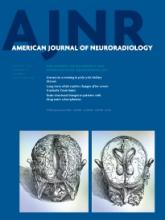Index by author
Fox, A.J.
- NeurointerventionYou have accessDifferences in the Angiographic Evaluation of Coiled Cerebral Aneurysms between a Core Laboratory Reader and Operators: Results of the Cerecyte Coil TrialI. Rezek, R.K. Lingineni, M. Sneade, A.J. Molyneux, A.J. Fox and D.F. KallmesAmerican Journal of Neuroradiology January 2014, 35 (1) 124-127; DOI: https://doi.org/10.3174/ajnr.A3623
Gabelic, T.
- EDITOR'S CHOICEBrainOpen AccessPrevalence of Radiologically Isolated Syndrome and White Matter Signal Abnormalities in Healthy Relatives of Patients with Multiple SclerosisT. Gabelic, D.P. Ramasamy, B. Weinstock-Guttman, J. Hagemeier, C. Kennedy, R. Melia, D. Hojnacki, M. Ramanathan and R. ZivadinovAmerican Journal of Neuroradiology January 2014, 35 (1) 106-112; DOI: https://doi.org/10.3174/ajnr.A3653
Healthy individuals who either had no relatives with multiple sclerosis or had a family history of it were studied and evaluated according the Okuda and Swanton criteria for radiologically isolated syndrome. These investigators found that the frequency of white matter signal abnormalities and radiologically isolated syndrome were higher in the healthy relatives of patients with multiple sclerosis compared with nonfamilial healthy control subjects. In healthy relatives of patients with MS, smoking and obesity also contributed to the presence of white matter lesions.
Galanaud, D.
- FELLOWS' JOURNAL CLUBBrainOpen AccessLong-Term White Matter Changes after Severe Traumatic Brain Injury: A 5-Year Prospective CohortJ. Dinkel, A. Drier, O. Khalilzadeh, V. Perlbarg, V. Czernecki, R. Gupta, F. Gomas, P. Sanchez, D. Dormont, D. Galanaud, R.D. Stevens, L. Puybasset and for NICER (Neuro Imaging for Coma Emergence and Recovery) ConsortiumAmerican Journal of Neuroradiology January 2014, 35 (1) 23-29; DOI: https://doi.org/10.3174/ajnr.A3616
The authors used DTI to study posttraumatic white matter changes over a 5-year period. Thirteen patients with severe injuries acutely showed significant fractional anisotropy decreases in the corpus callosum and corona radiata when compared with controls. These abnormalities progressed at 2 years and then remained stable until 5 years. The DTI abnormalities correlated with sequelae such as amnesia, aphasia, and dyspraxia.
Galluzzo, A.
- BrainYou have accessPatterns of Brain Structural Changes in First-Contact, Antipsychotic Drug-Naïve Patients with SchizophreniaM. Filippi, E. Canu, R. Gasparotti, F. Agosta, P. Valsecchi, G. Lodoli, A. Galluzzo, G. Comi and E. SacchettiAmerican Journal of Neuroradiology January 2014, 35 (1) 30-37; DOI: https://doi.org/10.3174/ajnr.A3583
Gasparotti, R.
- BrainYou have accessPatterns of Brain Structural Changes in First-Contact, Antipsychotic Drug-Naïve Patients with SchizophreniaM. Filippi, E. Canu, R. Gasparotti, F. Agosta, P. Valsecchi, G. Lodoli, A. Galluzzo, G. Comi and E. SacchettiAmerican Journal of Neuroradiology January 2014, 35 (1) 30-37; DOI: https://doi.org/10.3174/ajnr.A3583
Gati, J.S.
- BrainOpen AccessComparison of Multiecho Postprocessing Schemes for SWI with Use of Linear and Nonlinear Mask FunctionsM.P. Quinn, J.S. Gati, L.M. Klassen, A.W. Lin, J.R. Bird, S.E. Leung and R.S. MenonAmerican Journal of Neuroradiology January 2014, 35 (1) 38-44; DOI: https://doi.org/10.3174/ajnr.A3584
Ghodke, B.V.
- NeurointerventionOpen AccessCerebral Aneurysms Treated with Flow-Diverting Stents: Computational Models with Intravascular Blood Flow MeasurementsM.R. Levitt, P.M. McGah, A. Aliseda, P.D. Mourad, J.D. Nerva, S.S. Vaidya, R.P. Morton, B.V. Ghodke and L.J. KimAmerican Journal of Neuroradiology January 2014, 35 (1) 143-148; DOI: https://doi.org/10.3174/ajnr.A3624
Gomas, F.
- FELLOWS' JOURNAL CLUBBrainOpen AccessLong-Term White Matter Changes after Severe Traumatic Brain Injury: A 5-Year Prospective CohortJ. Dinkel, A. Drier, O. Khalilzadeh, V. Perlbarg, V. Czernecki, R. Gupta, F. Gomas, P. Sanchez, D. Dormont, D. Galanaud, R.D. Stevens, L. Puybasset and for NICER (Neuro Imaging for Coma Emergence and Recovery) ConsortiumAmerican Journal of Neuroradiology January 2014, 35 (1) 23-29; DOI: https://doi.org/10.3174/ajnr.A3616
The authors used DTI to study posttraumatic white matter changes over a 5-year period. Thirteen patients with severe injuries acutely showed significant fractional anisotropy decreases in the corpus callosum and corona radiata when compared with controls. These abnormalities progressed at 2 years and then remained stable until 5 years. The DTI abnormalities correlated with sequelae such as amnesia, aphasia, and dyspraxia.
Guglielmi, G.
- LetterYou have accessEst Modus in RebusG. Guglielmi and F. ViñuelaAmerican Journal of Neuroradiology January 2014, 35 (1) E1; DOI: https://doi.org/10.3174/ajnr.A3823
Gupta, A.
- BrainOpen AccessDoes the Location of the Arterial Input Function Affect Quantitative CTP in Patients with Vasospasm?B.J. Shin, N. Anumula, S. Hurtado-Rúa, P. Masi, R. Campbell, R. Spandorfer, A. Ferrone, T. Caruso, J. Haseltine, C. Robinson, A. Gupta and P.C. SanelliAmerican Journal of Neuroradiology January 2014, 35 (1) 49-54; DOI: https://doi.org/10.3174/ajnr.A3655








